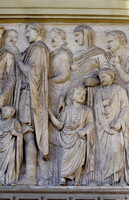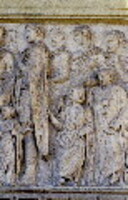| dc.coverage.spatial | Site: Rome, Lazio, Italy | en_US |
| dc.coverage.temporal | 13-9 BCE (creation); 1938 (restoration) | en_US |
| dc.creator | unknown (Ancient Roman sculptor) | en_US |
| dc.date | -13--9 | en_US |
| dc.date.accessioned | 2013-05-29T19:00:27Z | |
| dc.date.available | 2013-05-29T19:00:27Z | |
| dc.date.issued | -13--9 | en_US |
| dc.identifier | 222022 | en_US |
| dc.identifier.other | archrefid: 500 | en_US |
| dc.identifier.uri | http://hdl.handle.net/1721.3/129971 | |
| dc.description | The next group of figures, moving right along the South Procession, depicts the young General Lucius Domitus Ahenobarbus, who clings to the clothes of Drusus (this is the future father of Nero). Standing behind and to the right of him is Antonia Major; Dedicated on 30 January 9 BCE, the altar was erected in the Campus Martius by the Roman Senate to commemorate Augustus' return from Spain and Gaul on 4 July 13 BCE. The best-known exemplar of Augustan art, it is typified by its eclectic mix of Classical and Hellenistic elements and skillful amalgam of Roman myth-history and contemporary events. Source: Grove Art Online; http://www.oxfordartonline.com/ (accessed 9/1/2009) | en_US |
| dc.format.medium | marble | en_US |
| dc.rights | © Scott Gilchrist, Archivision, Inc. | en_US |
| dc.subject | allegorical | en_US |
| dc.subject | mythology (Classical) | en_US |
| dc.subject | portraits | en_US |
| dc.subject | rulers and leaders | en_US |
| dc.subject | Augustus, Emperor of Rome, 63 B.C.-14 A.D. | en_US |
| dc.subject | Julio-Claudian dynasty | en_US |
| dc.subject | Imperial (Roman) | en_US |
| dc.title | Ara Pacis Augustae | en_US |
| dc.title.alternative | Altar of Augustan Peace | en_US |
| dc.title.alternative | Ara Pacis | en_US |
| dc.type | image | en_US |
| dc.rights.access | Licensed for educational and research use by the MIT community only | en_US |
| dc.identifier.vendorcode | 1A3-R-R-AP-3-B9 | en_US |
| vra.culturalContext | Ancient Roman | en_US |
| vra.technique | construction (assembling) carving (processes) | en_US |
| vra.worktype | monument | en_US |
| vra.worktype | relief (sculpture) | en_US |
| dc.contributor.display | unknown (Ancient Roman sculptor) | en_US |



